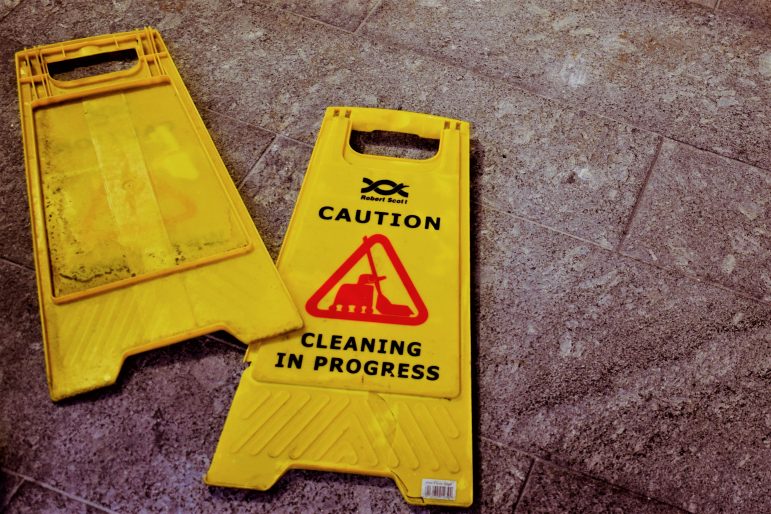Cleaning professionals are instrumental in keeping facilities and the people who visit, work, and live in these spaces safe. For more than a year, custodians and other cleaning professionals have been on the frontlines of the COVID-19 pandemic and were among those at the highest risk of being affected by the virus.
The pandemic greatly shifted the public’s expectations around cleanliness and how organizations approach cleaning and disinfection in their facilities. To address a new pathogen and maintain appearance, many cleaners were required to use chemicals, tools, and solutions with which they were unfamiliar.
Furthermore, some custodians did not have the proper personal protective equipment (PPE) because of widespread shortages. For example, one in five of the Service Employees International Union members didn’t have gloves and 40 per cent didn’t have face masks.
With cleaning professionals facing physical and environmental hazards each day, it’s critical that employers take necessary safety precautions.
Best practices for a better work environment
Now more than ever, cleaning professionals need to know that their employers are taking their safety seriously. Consider the following strategies for your staff or look for a building service contractor (BSC) that implements these best practices for their teams.
Regularly train employees
Prioritizing safety for cleaning professional starts with training. Without an adequate amount of training, custodial workers can injure themselves, whether it’s skin or eye irritation from incorrectly diluting chemicals or muscle strain from misusing equipment. Injuries can result in reduced productivity and time off for employees to recover. Training should be an ongoing process, beginning at the onboarding stage and continuing throughout their tenure. This ensures all employees are informed on the most up-to-date procedures.
Similarly, it’s just as important for employers to keep themselves updated with standards set by the Occupational Safety and Health Administration (OSHA). These play a critical role in minimizing or even eliminating certain hazards and help ensure a safe and healthy work environment. In the last year, many organizations have also committed to closely reviewing guidelines from the World Health Organization (WHO), United States Centers for Disease Control and Prevention (CDC), and the United States Environmental Protection Agency (EPA) to protect employees and building occupants as new information emerged during the pandemic.
Invest in high-quality equipment
Custodians are often faced with tasks that require repetitive and labour-intensive movements. These strenuous movements can sometimes cause employees to overexert themselves, which leads to musculoskeletal disorders such as back and shoulder injuries. Back injuries account for 46 per cent of injuries while shoulder injuries account for 15 per cent of musculoskeletal injuries in custodians and janitors.
Consider providing equipment such as robotic floor equipment that take away the strain and repetitive motions of washing floors or electrostatic sprayers that reduce the need for manual application of disinfectants. These simple changes can help avoid bodily injuries or soreness that can lead to long-term issues for cleaning professionals.
Substitute cleaning chemicals with nontoxic options
Cleaning professionals are cleaning more frequently than ever before, resulting in many facilities taking a closer look at the composition of their products. This is because overusing traditional cleaning chemicals that contain potentially toxic ingredients or strong fragrances can aggravate conditions like asthma and allergies.
Utilizing an on-site generation system to create non-irritating electrochemically activated solutions (ECAS) with just water, salt, and electricity greatly limits unsafe chemical mixtures. It also supports better indoor air quality (IAQ) because these solutions don’t contain volatile organic compounds. These cleaners and disinfectants address pathogens of concern and can easily replace most cleaning chemicals. An added benefit is that generating ECAS in a facility eliminates the chance of supply shortages that result in staff using unfamiliar chemicals.
Provide the proper PPE
PPE provides an essential layer of protection against workplace hazards like harmful chemicals and even viruses. Although using safer chemicals reduces reliance on gloves and eye protection, it is still important to make this equipment available to employees. From masks to gloves to protective eyewear, having these items at the ready shows that you care about prioritizing the safety of employees along with building visitors.
Show appreciation through education and benefits
Most cleaning professionals are not offered robust benefits, yet these can go a long way in creating a more engaged team and safer work environment. Employers can enroll employees in certification courses that expand upon best cleaning practices. This not only benefits their own safety, but supports the safety of building occupants.
As mentioned previously, being a cleaning professional requires labour-intensive work. Consider providing benefits such as healthcare packages so cleaning professionals are able to receive preventative medical attention to avoid injuries that require absences for long periods of time.
Safe employees = happy building occupants
Cleaning professionals are on the frontlines each day to help protect building occupants and visitors. Implementing strategies to promote the safety of these employees is key. Providing ongoing training and education, offering equipment to ease strenuous tasks, and substituting high-risk chemicals with safer and more sustainable cleaning solutions help employers uphold employee health and safety.
In turn, cleaning professionals will be more confident and engaged in their roles, resulting in fewer accidents, lower turnover rates, cleaner facilities, and higher customer satisfaction.
Kurt Kuempel is the General Manager of the Illinois and Wisconsin offices of GSF USA, a leading provider of sustainable cleaning services. For more information, visit www.gsf-usa.com or contact Kuempel at kkuempel@GSF-usa.com.








